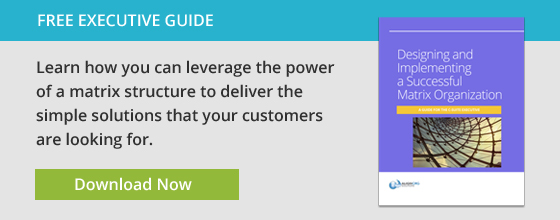Although matrix organizations are not new, they can remain puzzling even to the most seasoned executives. How can you recognize matrix driven issues when you, as an executive, are embroiled in the matrix itself? How can you evaluate the effectiveness of a matrix structure?
Rather than lump all the common matrix issues together, it is important to understand that not all failures in a matrix organization are created equal. Instead, it is helpful to separate the issues into two categories—strategic design issues and operational issues. Each type of issue necessitates a different treatment plan.
Optimizing Your Current Matrix Organization
Strategic design issues deal with the basic intent behind the matrix itself—how is the matrix designed to drive differentiation in the marketplace? Do employees clearly understand how the design is supposed to operate? Although not comprehensive, common issues might include:
- Failure to design mechanisms that facilitate planning, performance management, and resource allocation.
- Failure to maintain optimal balance of power/influence between and among matrix dimensions. Essentially, deciding who has control over resources and resource allocation.
While common strategic design issues center around the rationale for the matrix itself, operational design issues deal more with how work gets done inside the matrix, how decisions are made, and how resources are allocated. Some common failure points include:
- Failure to define roles, work processes, planning mechanisms, and decisions rights.
- Failure to anticipate conflicts in decision-making and resource allocation and decide how decision-making will work.
- Failure to select, develop, and reward leaders who can operate effectively in a matrix environment.
Ultimately, we need to ascertain through our diagnosis if the matrix is driving our strategy. While both kinds of issues—strategic and operational—can affect the effectiveness of the matrix, it can be tough to get traction, ask the right questions, and start to resolve the issues if you don’t pin down the primary failure point.
For example, if I conclude that a matrix is not driving the company strategy, I should adjust my questions accordingly. I might ask things like:
- Is there a lack of business rationale or understanding of the matrix?
- Is there a return on the matrix investment?
- Are there unclear benefits/risks?
- Are there disconnects between strategic and business planning processes?
- Is the culture conducive to a matrix?
If I find that there is a strategic rationale for the matrix, but the matrix is still not driving the desired results, the problem may reside with more operational issues requiring a separate series of questions like these:
- Are there unclear expectations from leaders?
- Are leaders properly modeling the matrix?
- Is there proper contracting among players at matrix intersections?
- Are decision rights clear?
- Are there performance management tools and forms?
- Do leaders have the necessary matrix skills?
Categorizing issues speeds up the diagnostic process and allows leaders to treat the right issues at the right level rather than waste time, training, and resources trying to fix the matrix alignment issue through the wrong means.
Setting Up a New Matrix Structure for Success
Evaluating whether a new matrix organization is needed has some similarities with the diagnostic process outlined above. Both require that business leaders understand the different aspects of a matrix organization—strategic and operational. Evaluating the matrix situation up front helps avoid confusion, saves time and resources, and paves the way for a superior outcome if it is determined that a matrix structure is the right fit for your organization.
To see how an evaluation of this kind might work, consider a simple matrix evaluation checklist we use in our practice:
Is the Matrix Structure needed?
Yes or No?
- Strong business or strategic rationale or understanding for matrix
- Clear return on matrix investment
- Explicit benefits/risks for the matrix
- Aligned strategic and business planning processes
- Human capital processes support matrix
- Clarity around the roles of functions, geographies, and business units and how work will be performed or value created
- Culture is conducive to matrix and leaders have skills and experience
You should note that the first four items deal with strategic questions while the remaining three address more operational needs. This quick checklist allows businesses to quickly evaluate if their organization has considered and addressed the key aspects of a matrix organization that will lead to success.
Diagnosis and evaluation are a vital part of any effective matrix organization. A matrix organization can be a great tool to drive your strategy and produce market differentiation, but it still necessitates regular evaluation and diagnosis to keep it running smoothly and an evaluation to determine if it is the right fit for your organizational situation. Executives can save valuable time, effort, and money in their evaluations and diagnoses by categorizing matrix issues and questions into strategic and operational issues and then learning from common failure points. Recognizing and fixing potential issues before they take root in a matrix organization can save a lot of frustration and cost in the long run.






